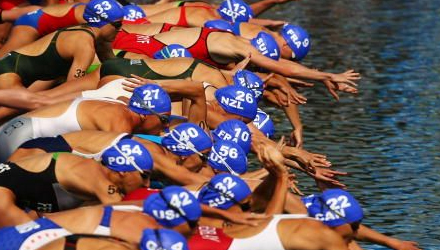If you catch the person in front of you and wish to overtake then the overtaking swimmer should gently but distinctly touch the feet of the swimmer being overtaken. It may take two or three touches, but overtaking swimmers should not need to repeatedly slap or grab at the legs of a slower swimmer to politely make their presence known.
A lead swimmer who feels a touch on the feet from an overtaking swimmer, should continue to the next wall, then stop in the corner of the lane to let faster swimmers past. A single light touch may be accidental and can be ignored, but two or more distinct touches should be regarded almost universally as a request to swim through.
Swimmers enjoying a draft behind a strong lead swimmer, but who are just barely able to hold that pace should think twice before tagging the leader's toes and requesting to move ahead. In such situations, it's highly unlikely that the (formerly) trailing swimmer will be able to hold the same pace for very long when leading without the draft. This can lead to repeated "leap-fogging" and unnecessary contact, which can be annoying and disruptive for everyone in the lane.
Drafting swimmers not wishing to pass should swim far enough back from a lead swimmer that they don't inadvertently touch the lead swimmer's toes.
If resting or starting do not push off in front of an approaching swimmer unless you are sure you are faster and they will not catch you.
Top ten tips to a fast swim Transition
- Kick hard for 50 metres before you stand up to get the blood into the legs and stop that light headed feeling = more co-ordination, faster transition.
- Swim as far into the bank before standing up.
- Get water into the suit before you stand so it buoys the wetsuit from the skin as it runs though. The suit will then fall off if you follow procedure below.
- Put your goggles onto your forehead and leave them until the wetsuit is off.
- Left hand behind the neck open the velcro and don't let go.
- Right hand behind the back pull the zip cord all the way in one go.
- Left hand pulls the suit just over the shoulder then goes to the right side.
- Left hand pulls the right side down and in one go it rolls off the arm.
- Do all this while you steadily move to your shoes.
- At your transition point execute the Kick & Flick to get the suit of over your feet.
Why the suit gets stuck
- The flap behind the zip is twisted.
- You didn't pull the zip tight as you pull the strap down.
- You let go of the neck velcro too soon.
- Don't bend the elbow when you roll the suit off the arms.
- keep moving forward out of the water. If you stop you may feel dizzy and fall over!
Don't start at the back!
The 'bun' fight as we like to call it comes from individuals desire to get away quickly and in most cases away from the masses.
No one is ever trying to grab or kick you on purpose, they are all very nervous and thinking exactly the same as you. It can be very difficult to avoid bumping into people. One of the things that people tell me is that they will start at the back to avoid this.
The trouble is everyone is trying to do the same thing so you can imagine 100+ triathletes there as the gun goes waiting for everyone else to go first. "after you" "no after you" "no you first".. So 'don't start at the back'.
Look for the racing line to the first buoy. This is the shortest route. Then look at where most people are bunched up at the start. Go to the side of these people but not at the back.
Just before the gun goes get into what we call a 'deep water start position' This is as horizontal in the water as possible. Use the buoyancy of the wetsuit to help you do this. So when the gun goes your legs are already up and you can start immediately. Swim hard but not too hard, you don't want to go anaerobic.
You need to sustain a fast pace for 50>100 meters giving time for people to find their line and space out. Swim with a real economy of effort directly behind the person in fronts feet. Try not to hit their feet though. Breathe every two strokes to ensure you get enough oxygen in.
Session Plans
There are 6 session plans that will help both newcomers to o/w swimming and those focused on particular race performances with ideas on technique to get the most out of their open water sessions.
They build on a lot of the skills we have worked on in the pool sessions but help make the transition to open water and wetsuit swimming.
- Open Water Session Plan 1
- Open Water Session Plan 2
- Open Water Session Plan 3
- Open Water Session Plan 4
- Open Water Session Plan 5
- Open Water Session Plan 6
Skill Sessions
